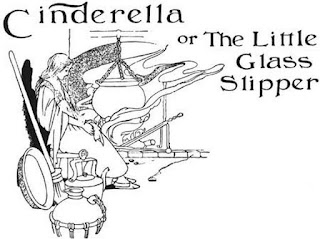Goose Girl
Goose Girl, ilustrated by Charles Robinson
Goose Girl is a fairy tale written by the brothers Grimm. It deals with all the major questions and themes from their collection: social status, trickery, the importance of a given word, marriage, and rigorous punishment.
We'll summarize the story with the help of Charles Robinson's illustrations from the book The Big Book of Fairy Tales. As with all other fairy tales in this book, it starts with a typical decorative letter.
Once upon a time, there was a princess whose father died. Her mother arranged a marriage to her daughter with a prince from another kingdom. The princess has to leave and only one servant (a waiting maid, actually) comes with her. She also gave her a handkerchief with three drops of her blood and a talking horse.Both had the power to remind the princess of her royal origin but she was so inexperienced she didn't really understand it.
After some time, the princess became thirsty. She asked her companion to bring her some water from the brook but the maid denied her request. She said she won't be her servant anymore.
The princess
leaned over the brook and drank water directly from the ground without
using her golden cup. The handkerchief warned her about her inferior
behavior but the princess didn't know what to do.
At the next
brook, the scene repeated and the princess lost her handkerchief without
even noticing it. But the servant did. She knew she gained power over
the princess and demanded they switch the roles.
The servant will
be presented to the prince as the princess and the princess will become
her servant. The real princess had to give her word to the false
princess that she'd never tell the truth to any living being.
When both girls arrived nobody noticed the switch. The false princess started with preparations for the wedding and the real princess got a job. She became a goose girl. How about the horse? The false princess ordered his slaughter and his head hung on the city door.
The real princess became a goose girl. When she took geese out of the town and back, the head of her dead horse reminded her of her royal origin but she didn't know what to do. She felt weak and after all, she gave her word. She won't tell the truth to any living being.Her golden hair was the last sign of her royalty and there was nobody to see it or even help her.
Well, somebody actually noticed her hair when the wind took off her hat. It was a boy who went to the pasture with the goose girl. He had never seen anybody with so lovely hair. It shined like real gold!The boy told the king what he saw. The king was already suspicious about the girl who was supposed to be a princess but didn't behave as he expected. He wanted to know who the goose girl really was.
But she couldn't tell him. She gave a word and a given word is sacred to the royalty. Fortunately, the king was wise and experienced. He assumed the goose girl is obligated by her promise which, if she is of real royal blood, won't break.
So he arranged that she could talk with an iron stove. Iron stoves aren't human beings, right?When the goose girl decided to trust her problems to the iron stove, the king was listening on the other side. He finally connected all the dots. He decided to act.
At dinner, he asked the false princess about the imaginary situation of somebody stealing somebody else's identity presenting himself as that person. What kind of punishment would be appropriate for such a thief? After all, he stole somebody else's life!
The servant was intoxicated from her role as the false princess and suggested a very cruel punishment. In her opinion, such a person should be stripped naked and locked in a barrel. Then a pair of horses should pull the barrel as long that thief dies.
Unknowingly, she wrote her own death sentence.
The goose girl regained her status without breaking her word. She became the wife of the prince and they lived happily ever after.
This interesting fairy tale is very rich with symbolism and inspired numerous artists to portray the scenes from the story. To learn more about it, visit the article about Goose Girl.
If you want to add something to our retelling, feel free to leave a comment.











Komentarji
Objavite komentar